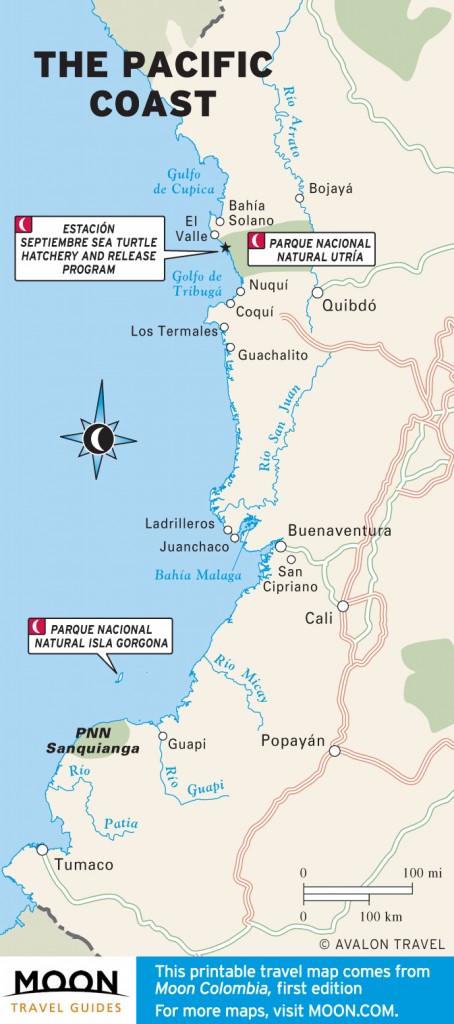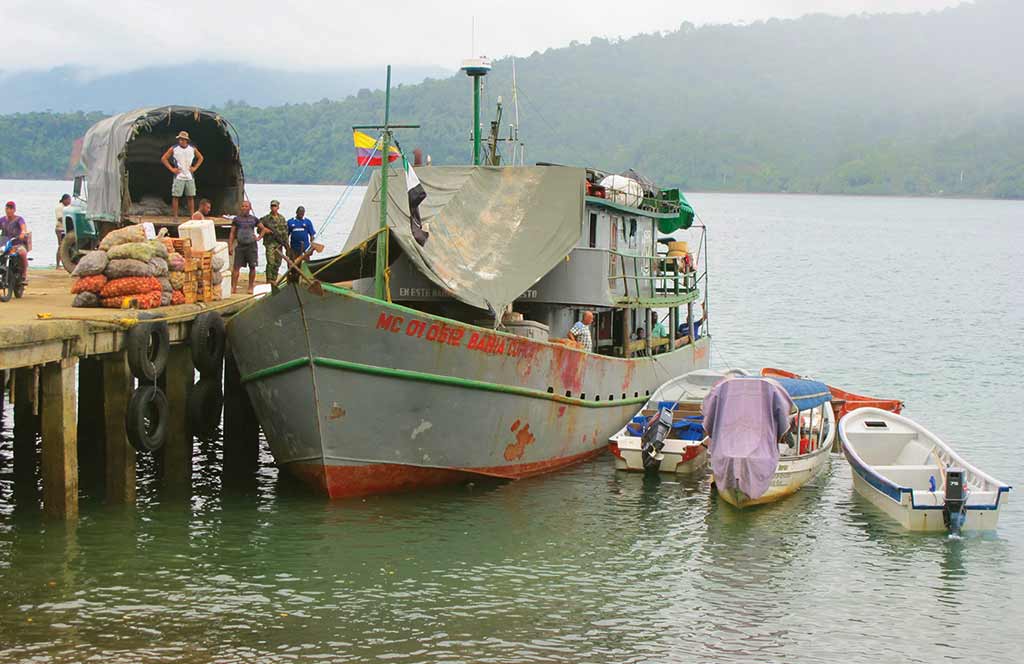When many visitors arrive at the tiny Bahía Solano airport, after they collect their bags they head straight to the village of El Valle about 22 kilometers (14 miles) away and to the hotels on the beaches of Playa Almejal. But Ciudad Mutis, as Bahía Solano is officially named (after the famed botanist), is actually a good base for your visit—there’s no need to rush off. It is one of Colombia’s sport-fishing capitals, and excellent diving and whale-watching excursions can be arranged from here. The town, although the largest one in the Chocó Pacific coast, is small, and everywhere is accessible on foot.

Colombia’s Pacific Coast
The town, although the largest one in the Chocó Pacific coast, is small, and everywhere is accessible on foot.Nice jungle walks to swimming holes fed by crystalline freshwater waterfalls are within walking distance from the town, and depending on the tides, you can also walk to the beaches of Punta Huína and Playa Mecana. These can also be easily reached by boat. During low tide, the bay becomes a soccer field; when the tide comes in, it’s a place to cool off.There are three easily done walks in or around Bahía Solano. Punta Huína, Playa Mecana, and the Cascadas Cocacola can also be reached on foot, and are all under two hours walking from town. You may want to go with a guide (hotels can arrange this) at least the first time, and find out the day’s tide information before heading out. If the tide has come in, you’ll have to take a boat back to the town.
The Virgen de la Loma path is an easy, 30-minute climb up through lush vegetation to the top of a hill with a nice view of the bay. The entrance to the trail is well-marked and is only 20 meters from the Hostal del Mar. For this you’ll need no guide. About two blocks from there on the west side of town is the trail to the Cascada Chocólatal, which takes you along a river to a roaring waterfall. Taking about 40 minutes or so, this hike may not necessarily require a local guide, but it may be helpful, especially so you’ll have someone with trained eyes to point out the occasional colorful frog, lizard, bird, or humongous spider to you. Otherwise they are quite tricky to spot. You will have to crisscross the narrow, shallow creek several times, and it can be treacherous as the rocks are slippery. You’ll need to have both hands free. Wear a bathing suit so you can frolic in the cool waters of the swimming hole at the five-meter waterfall. That’s your refreshing reward!
The third hike is called the Cascada del Aeropuerto. This hike is right across the street from the airport and leads to a towering jungle waterfall. You probably won’t need a guide, but it is not impossible to become lost. Follow the stream and note that it will eventually veer to the left. It’s about a half hour walk. All of these paths are maintained by a group of community members with the help of high school students who have posted signs to point the way.
The waters off of the Chocó coast are excellent for sport fishing. The Posada Turística Rocas de Cabo Marzo (tel. 4/682-7525, cell tel. 313/681-4001, [email protected]) regularly organizes fishing adventures in the area. Species that can be found in the waters here include marlins (blue, black, and striped) and sailfish. These are considered endangered and are caught and then released. Yellowfin tuna, red snapper, wahoo, and sierra are other fish that are caught and eaten. The best time of the year for fishing is March-June. Between October and December is also a good time to fish (catch and release) for marlin and sailfish, but this is a rainy season and the waters are rough. Rental of a boat and an eight-hour day excursion costs around COP$1,600,000, with a maximum of four fishers.

The port of Bahía Solano. Photo © Andrew Dier.
Rocas de Cabo Marzo organizes catch-and-release tournaments like the Torneo Internacional de Pesca Deportiva. The tournament takes place far from the coastline, as much of the Chocó coast, especially around the Cabo Marzo area, is protected as a Zona Exclusiva de Pesca Artesanal del Chocó (ZEPA). That means it is limited to only local fishers using their traditional fishing methods. This initiative is supported by Conservation International.’
Diving in the Pacific is much different from diving in the Caribbean. First of all, it’s more expensive, due to the high price of gasoline. Secondly, the variety of fish is different: While in the Caribbean it is common to see colorful tropical fish, in the Pacific the fish are much larger. Both Posada Turística Hostal del Mar (tel. 4/682-7415, cell tel. 314/630-6723) and Posada Turística Rocas de Cabo Marzo (tel. 4/682-7525, cell tel. 313/681-4001, [email protected]) offer diving excursions. A popular trip is to the shipwrecked Sebastián de Belalcázar just to the northeast of Bahía Solano. Another good place to dive is around Cabo Marzo to the north near the Panamanian border. Rocas de Cabo Marzo charges COP$120,000 per person (without equipment) for a diving trip to that location. Double-check on the security situation before going to Cabo Marzo, as drug traffickers operate in the area.
Excerpted from the First Edition of Moon Colombia.